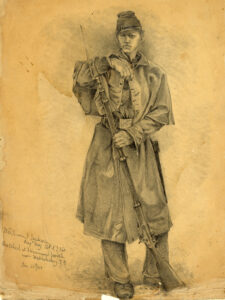Depressed and restless after two weeks of idleness in their regiment’s ice- and mud-encrusted camp outside Washington, D.C., Pennsylvania cavalrymen Tom Smith and Sam Boyer rode into town in January 1862. in their regiment’s Smith stopped for a haircut and a shave, and nearly fell over when the barber charged him $1.25. Outraged at this double fleecing, the Yankee corporal “gave him 50 cents and told him to go to the Devil.”
Later that day, Smith found himself looking over a new pair of boots while his messmate bargained with a shopkeeper for a better price. As Smith “stood at the stove with the boots in my hands, they got a little warm and one of the soles fell off.” With the merchant’s curses ringing in their ears, Smith tossed the shabby shoes on the floor, and he and Boyer headed out of town angrier than they had been going in.
“I went to Washington City,” Smith wrote home, “and of all the Mud Holes that I have been in I think that Washington will take the Premium. The Store Keeppers and People in general are nothing but a set of Thieves and sharpers and their main object is to cheat the soldiers out of their money.”
Not yet through training, these Yankee troopers had already encountered one of war’s ugly byproducts—the profiteer. At every turn, it seemed, soldiers could find a greedy merchant, government contractor or sutler only too happy to trade shoddy, overpriced products for a fighting man’s hard-earned wages. And with soldiers— especially inexperienced soldiers—often short on clothing or food, they were easy marks.
As Smith and Boyer found out, early-war Washington was filled with unscrupulous opportunists eager to take advantage of needy soldiers directly or through the accommodating office of Secretary of War Simon Cameron. Quartermaster General Montgomery C. Meigs eventually managed to eliminate much of the waste, but the byproducts of Cameron’s careless dealings—especially in low quality shoes—were everywhere. One contract alone cost the Union nearly $170,000, when Army of the Potomac inspectors judged 25,000 “new” winter coats to be worthless.
Things were at least as bad in the South, where soldiers at the front suffered acutely at the hands of speculators back home. In a two-volume war diary, Howard Swiggett, a clerk in the Confederate War Department, railed against the South’s civilian hoarders, corrupt commissary officers and greedy railroad officials for depriving soldiers of food and clothing. “The rogues among the multitude of quartermasters have made fortunes themselves, and almost ruined the country.” After spending $5 on a quart of beans, Swiggett wrote, “I fear a nation of extortioners are unworthy of independence….”
Even the shadiest quartermaster hated the army sutler, whose constant presence among troops gave him a lucrative monopoly. From wagons rattling along the roadside or log huts assembled in camps, these civilian proprietors hired by the army (usually one per regiment) offered convenience and variety—at a huge markup, naturally. “A hungry man,” one exasperated Yankee wrote, “could invest five dollars for a dinner at one of these establishments and scarcely do justice to his appetite.” Desperate for a new shirt ($5), a pair of shoes ($15) or something edible to augment meager army fare, soldiers often found themselves in debt to sutlers. While some men blew their pay on illegally sold liquor, most found the salesman’s selection of canned meats, oysters, fruit, cheese, butter, onions or eggs—which were often of dubious quality—hard to resist. Famished infantrymen of the 40th New York bought watermelons for a dollar apiece— from a sutler who had bought 100 of them for just $5!
None of this sat well with veteran fighting men. If they could do nothing directly about corruption or skyrocketing inflation, they could at least vent their anger against their immediate tormentors, and sometimes did. Members of the 9th Texas Cavalry threatened to hang one sutler, then laid siege to his hut, “literally causing the old fellow to leave in haste the next morning.” Sympathetic Union officers often turned a blind eye while their men used the same sort of tactics to express their frustration.
“It is always safe to reverse the rule of common law,” one quartermaster said, “and adjudge a sutler guilty until he prove his innocence.” Soldiers might have said the same about him.
Originally published in the May 2006 issue of Civil War Times. To subscribe, click here.




